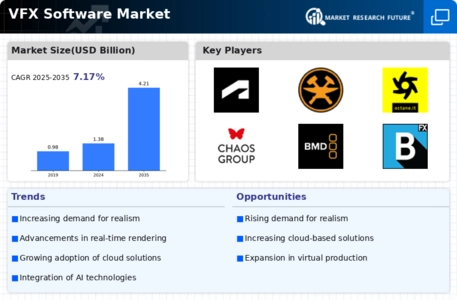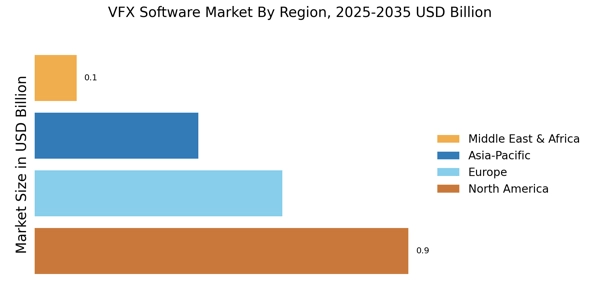Advancements in Technology
Technological advancements play a crucial role in shaping the VFX Software Market. Innovations in artificial intelligence, machine learning, and real-time rendering are transforming how visual effects are created and integrated into projects. For instance, AI-driven tools are streamlining workflows, allowing artists to focus on creativity rather than repetitive tasks. The introduction of real-time rendering engines has revolutionized the production process, enabling immediate feedback and adjustments during the creative phase. As these technologies continue to evolve, they are likely to enhance the capabilities of VFX software, making it more efficient and user-friendly. This trend suggests that companies that adopt cutting-edge technology will have a competitive edge in the VFX Software Market.
Growing Popularity of Gaming
The gaming industry has emerged as a significant driver for the VFX Software Market. With the rise of immersive gaming experiences, developers are increasingly utilizing advanced visual effects to enhance gameplay and storytelling. The VFX Software is projected to exceed 200 billion USD by 2025, with a substantial portion of this growth attributed to the demand for high-quality graphics and VFX. As gamers seek more realistic and engaging experiences, game developers are investing in sophisticated VFX software to create visually stunning environments and characters. This trend indicates a robust future for the VFX software sector, as it adapts to the evolving needs of the gaming community.
Rising Demand for Visual Content
The VFX Software Market experiences a notable surge in demand for visual content across various sectors, including film, television, and advertising. As consumers increasingly gravitate towards high-quality visual experiences, the need for advanced VFX software becomes paramount. In 2025, the market is projected to reach a valuation of approximately 10 billion USD, reflecting a compound annual growth rate of around 12%. This growth is driven by the proliferation of streaming services and the increasing production of original content, which necessitates sophisticated visual effects to captivate audiences. Consequently, companies are investing heavily in VFX software to enhance their creative capabilities and meet the evolving expectations of viewers.
Expansion of Virtual and Augmented Reality
The expansion of virtual and augmented reality (VR and AR) technologies is poised to significantly impact the VFX Software Market. As these technologies gain traction in various applications, including gaming, education, and training, the demand for VFX software tailored for VR and AR experiences is likely to increase. In 2025, the VR and AR market is expected to reach approximately 300 billion USD, creating new opportunities for VFX software developers. This growth suggests that companies will need to adapt their software to accommodate the unique requirements of immersive environments, thereby driving innovation and enhancing the overall capabilities of VFX tools.
Increased Investment in Entertainment and Media
The VFX Software Market is significantly influenced by increased investment in the entertainment and media sectors. As production budgets rise, filmmakers and studios are allocating more resources to visual effects, recognizing their importance in storytelling. In 2025, the entertainment industry is expected to invest over 200 billion USD in content creation, with a substantial portion directed towards VFX. This influx of capital not only boosts the demand for VFX software but also encourages software developers to innovate and enhance their offerings. As a result, the market is likely to witness a proliferation of advanced tools and features, catering to the diverse needs of content creators.


















Leave a Comment